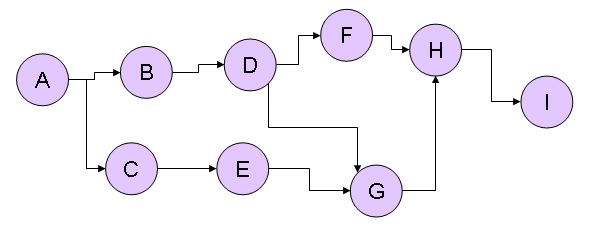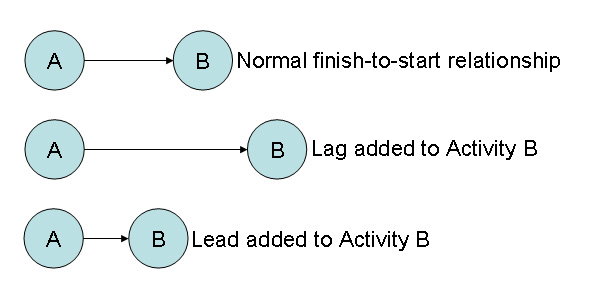The 8/80 rule states that any work package in a work breakdown structure (WBS) should not take more than 80 or less than eight hours to complete. Don't want to over-engineer any WBS, but not so general as to make project steps ambiguous.
The Project Network Diagram (PND) helps to visualize the work.
Lag and lead time
To create an estimate that's accurate or close to accurate, it's really more than just adding up the activity durations. We also have to consider several factors that could wreck the schedule, and drive managers nuts (from Joseph Phillips http://www.informit.com/articles/article.aspx?p=369224&seqNum=2):
- Constraints.
- Assumptions.
- Available resources.
- Law of Diminishing Returns. The Law of Diminishing Returns controls yield against the amount of labor available. Suppose we have an activity that will take 40 hours with two network engineers assigned. If we add two more network engineers to the activity, can we finish the work in 20 hours? Maybe. If we add 40 network engineers to the activity, can we get done in a few minutes? Not likely. In addition, not all activities are effort-driven; many are of fixed duration. This is a nice way of saying that it doesn't matter how many experts you throw at the activity—it will still take the same amount of time to complete.
- Parkinson's Law. Parkinson's Law states that work will expand to fill the amount of time allotted. Imagine that Joe says an activity will take 40 hours to complete, although he knows he could finish the work in just twelve hours. He's added padding to account for potential mistakes, issues, and games of solitaire he may encounter. Magically the task will grow to take the allotted 40 hours. Think of your workload the day before you leave for vacation. You can crank and get it done. But the day after vacation? Takes all day to send one email. (Maybe not you, but probably that guy in the cube next to you.)
- Risks.


No comments:
Post a Comment